
WP's HP: HOME
| SloMo: Links
~ [FAQ] ~
Info ~ Tips
~ Data ~ Clips ~ HYCAM ~
Freq. ~ f-Calculator ~ Trigger ~ Image
RAM | ?Help? | Deutsch

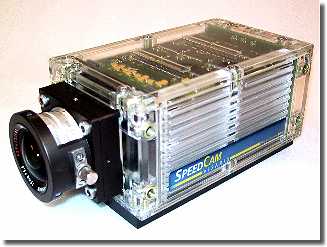
Digital HD high-speed camera, 10 000 frames/sec
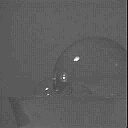
Bursting soap bubble
slowed down 500 times
Elementary questions coming up, when talking about
digital high-speed cameras and slow motion systems. Not all, but a
lot about high-speed and SloMo cameras.
This here is not an advertisement site - links to
various manufacturers and systems you will find in [SloMo Links].
Sample sequences:
MORE
Some typical high-speed camera technical
data:
MORE
Well, it's just a little bit more: Fully digital high-speed
video cameras achieve at TV quality (PAL/NTSC or even
better than HDTV) more than 1 000 frames per second
(like progressive scan, i.e. without interlacing in
black-and-white or True Color). By reducing the resolution
(binning) or the format (reading a part of the sensor only) system
depending a maximum framing frequency of several
10 000 up to much more than 100 000 frames/sec
is possible. Even just more than 1 million frames/sec are
technologically feasible by that. (By the way there also exist the
abbreviation fps for frames per second and Hz for 1/second.)
The combination with special strobe lights for multi-time
exposure permits frame rates far above this.
Single to multi-channel systems and even shock resistant versions
are available.
Concerning expenditure and capabilities it is better to speak of
an optical measurement appliance than of a (video) camera.
Consequently several high-speed cameras additionally offer frame
synchronous analogue and digital data acquisition channels.
No really it isn't. Such cameras are used e.g. in automobile industry and its suppliers (crash test, air bag, tire engineering, hydraulics, ...), in special mechanical engineering (packing machines, machine-tool building, robotics, lumber industry, ...), in quality assurance (material testing, crack testing, ISO 9000/CE documentation, control, ...), in mass production (cable making, plug and socket connection, rack off facilities, welding facilities, ...), in service use (common adjustment, printing industry, printed circuit board assembly, chip card manufacturing, ...), in medicine (gait analysis, rehabilitate and recovery, ergonomics, forensic, ...), in sports (training, documentation and teaching, material development, movement analysis, ...), in advertising and show business (TV adverts, special effects, music videos, ...), in heating and combustion engineering, in animal research, in mining, in structural and civil engineering, in sportswear industry, in kinematics and fluid mechanics science, in air and space engineering, in military engineering, ...
Well, of course, a special sensor designed for high-speed
demands is used. The performance of high-speed cameras, however,
derives less of the poor clock rate, but of the parallel structure.
Normal speed CCD or CMOS cameras read out the sensor just at one
single spot. A frame (charges in the sensor matrix) is pushed pixel
by pixel from this read out line into the processing electronics.
Then the remaining frame is shifted in one step by one line in
order to fill this read out line again and the read out process
starts once more. And so on until the sensor is regularly read out
empty completely. Because so an information spread over an area is
transformed into a serial data stream one speaks of
serialization.
Sensors of high-speed cameras are usually designed in a very
parallel structure. Multi-frame single shot cameras expose the
sensor several times at different areas and/or just use it as
memory as well, which is read out afterwards with normal speed. In
sequence cameras the sensor offers several independent read out
channels including electronics. Casually spoken one has several
cameras in the same housing. For instance the »VGA class« CCD
sensor HS0512JAQ of EG&G Reticon (ca. 1995) has 16 of these
read out channels, the »HDTV class« CMOS FhG/CSEM Cam 2000 sensor
(ca. 2001) offers 32 analogue and the megapixel CMOS Photobit
PB-MV13 (ca. 2003) 10 digital ones. The image data are buffered in
memory banks via a wide bus or channel architecture from where they
are read out with standard speed.
Usually the sensor runs with a fixed clock speed of several ten to
some hundred megahertz with high pixel count imagers. So the
maximum read out rate (pixels per second) and the maximum framing
frequency (complete sensor per second), resp., are limited. When
one wants to exceed this nominal frequency, one will have to
decrease the number of pixels per frame to be read out. Just
because of the fixed read out rate. One achieves that by reducing
the read out area step by step. Thus quite a few thousand up to
more than one million frames per second are within ones reach. But
take notice in view of smallest »peepholes« such a top score is
more useful for sales promotion than for application. Not to
mention the extreme demands for illumination due to short times
of exposure.
Indeed it is, but it usually is only capable of 25 or 30 full
frames/sec, possibly 50 or 60 interlaced half frames per second
only. In between a lot of information is lost. (One starts to talk
about high-speed cameras when frame rates of more than 160
frames/sec and a serial of least three photos in a row or with 125
frames/sec with a time of exposure less than 1 microsecond are
achieved, refer e.g. to EU Dual Use Regulation Export List
paragraph C, 6A003.)
Practice-oriented example: A comparison of different chisels of a
turning lathe and their shavings is to be done. The workpiece
rotates with 3 000 rpm, which are »ridiculous« 50 revolutions
per second. Nevertheless, with 25 (30) frames/sec only each second
revolution is caught. With 1 000 frames/sec each 18° a frame
is won, thus 20 of one revolution.
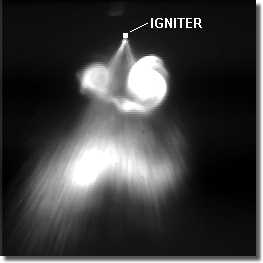
Gas and particle exhaust of an igniter
Which reminds us of the next item: The object to be shot does not stop in best pose during the picture is taken, but continues moving. A single picture covers the MOVEMENT of the object during a CERTAIN SPAN OF TIME, i.e. the time of exposure. (This as difference to a flip book ;-)
The photo on the right shows one frame out of a
sequence shot with 1 000 frames/sec. One sees the blow-out of
an initiator (size approx. like a finger tip), e.g. as used to
start the pyro charge of an airbag or a rocket kit, about 3
milliseconds after ignition.
While the gas cloud eddies are sharply captured by a time of
exposure of 1/10 000 seconds, the blown out red-hot particles,
however, appear as stripes only, due to motion blur. The already
reduced time of exposure is not short enough to freeze their
movement.
Practice-oriented example: The workpiece mentioned above has a
diameter of 100 mm (approx. 4 inches), the exposure is
1/1 000 sec. Then 18° would be 15.7 mm (approx. 0.62
inch) the surface of the workpiece rotates on. If this is too much,
the time of exposure will have to be reduced (and/or the frame rate
has to be increased). How, you will find at [SloMo Tips] in
this site.
Concerning movement analysis one has take into account the
Nyquist-Shannon-Kotelnikov theorem of sampling: To reconstruct (an
oscillating) movement one has to use at least the double scanning
frequency than that (frequency) of the movement.
Practice-oriented example: A valve or a loud speaker let out the
chamber tone »a«, they oscillate with 440 Hertz. (That's about
the sound of the »ahhh« one says at the dentist.) To follow the
movement of the membrane one needs at least a frame rate of 880
frames/sec (1 Hz (Hertz) = 1/sec). As practice shows even with
much more.
A short comparison with military demands shows what extraordinary
frame rates must be taken into account.
Practice-oriented example: One wants to see the bullet leaving the
barrel of a standard military gun like the AK-47 (Kalaschnikow) or
the G3 (Heckler & Koch). The V0 of the projectile at the muzzle
exceeds two times the speed of sound, let's say 680 m/sec
(2 230 feet/sec). Thus during one thousandths second the
projectile moves more than 0.68 m (2 feet 3 inch) and you will
get a stroke of this length as image, if you do not reduce time of
exposure. With a time of exposure of one ten thousandths second the
stroke length reduces to just about double the projectile length
only. That implicates when you want to watch a bullet penetrating
the target, you will need frame rates of several thousands to some
ten thousand frames/sec at least.
By the way: Pistols and revolvers fire their bullets with about
275 m/sec (~ 900 feet/sec) and more, some shells of artillery and
tank cannons reach more than 1 600 m/sec (~ 1 mile/sec) and
additionally rotate round their longitudinal axis.
Therefore - do not underestimate the necessary frame rate,
especially not with rotating objects and explosions.
The limitation is not the memory medium alone. One can also
integrate a harddisk drive or connect the camera with USB or
Ethernet, etc. And it is really done. The image data, however, are
generated so fast that a common interface is not able to read out
them from a therefore necessary buffer memory. A megapixel sensor
generates at 1 000 frames/sec just about 1 GByte of
data per second. Therefore the USB connector is rarely seen at fast
high-speed cameras with high resolution. Refer also to [SloMo
Image].
With moderate demands for resolution and frame rate it may be
possible to select a low end camera system capable of directly
writing the image data to a harddisk of the control device, as a
rule a notebook, during a longer period of time. That works about
with VGA resolution and 100 to 200 frames/sec.
In the other direction, if one desires a usable resolution at
extreme high frame rates, even the connection between sensor and
buffer memory turns to time critical. Then it is not made of
separate ICs, but memory cells or memory areas are directly
arranged on the sensor or even around the pixel. Of course, the
recording time is further limited by that.
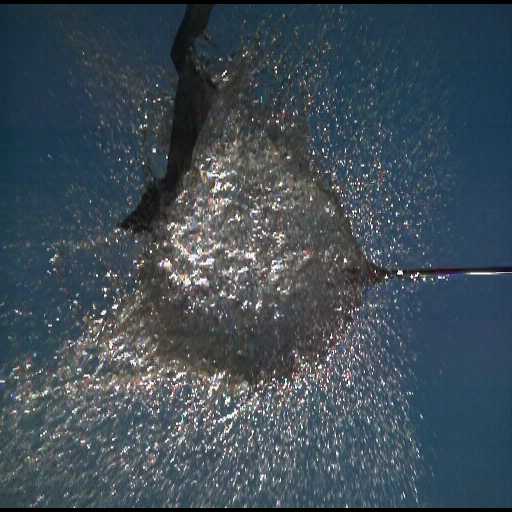
Bursting waterfilled balloon
No, actually it isn't - because what goes fast, is often over in
a moment. Not to mention the image memory of digital high-speed
camera systems is organized like an endless loop buffer. Due to the
installed hardware capacity, frame rate and resolution it is
overwritten after every e.g. 4 seconds. The system is able to lie
in wait in this mode for hours or days. After it gets its trigger
signal the real grabbing is made the overwriting process is
stopped. What one really gets can be pre-selected with the trigger
position.
Practice-oriented example 1: In a facility for filling bottles
break into pieces at a certain place but in uncertain intervals.
One is looking for the cause. The camera is adjusted towards the
scene of interest and the trigger input of the camera system is
connected to a microphone. The trigger position is set to 100%,
i.e. end position. The camera system is running in record mode
overwriting the image memory (here e.g. sized 2 seconds). The sound
of the breaking bottle releases the trigger. The recording stops
and in the image memory of the camera system remains the 2 seconds
»history« made before the sound has caused the trigger.
Practice-oriented example 2: An analysis of the start phase of a
sprinter in a 100 m competition is to be done. The trigger of
the camera system, with e.g. 1 second image memory extension, is
set to 25%, the trigger input is connected to the starter's pistol
and the system is set to record mode. Then one catches 0.25 seconds
before and 0.75 seconds after the start shot.
Some high-speed cameras offer the chance to use the image RAM
sequentially. This partition mode means one can shot several short
independently triggered takes without the image RAM being filled at
once by just a single sequence. More about calculating the memory
demands you will find at [SloMo Data] in
this site.
And finally something about duration: When you watch the 4 seconds
you have recorded with 1 000 frames/sec, you will do this
slowly - that's the idea and purpose of slow motion. With a replay
speed of e.g. 1 frame/sec you will get regular movies nearly
lasting 67 minutes, but often with a rather meager plot. Therefore
usually the systems offer the possibility to cut the sequences
before storing them on a durable storage medium.
No really it isn't, one has other claims to photos. Often detail
enlargements are necessary, because the digital photo devices offer
a very restricted focal length adjustment only. Moreover the images
are stored (not lossless) compressed to overcome the huge data
flood. Thus they really have not the advertised resolution. And
somehow one has to get rid of the data amount: An uncompressed
megapixel image has at least 1 MByte, with True Color even
rather more. And practically spoken: What device just permits to
replay streams of real megapixel images with data rates of
GByte/sec fluently?
Besides a higher resolution just causes smaller pixel, because the
sensor size is even limited by the lens design. Smaller pixel,
however, are more susceptible to noise and usually demand more
illumination.
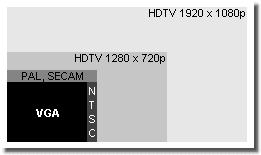
VGA, traditional and new TV formats
Therefore a comparison with broadcasting and video technology is
more useful, because it is primary based in the moving frames
sector as well, and I suppose TV equipment is within everyone's
reach (or memory ;-). The visible resolution of a PAL/SECAM (CRT-)
TV set amounting to 720 columns x 576 lines (not 768 columns as the
4:3 side ratio seems to claim) is reduced by S-VHS recorders to 576
x 400 and by VHS recorders to 576 x 240. From TV sets according to
NTSC norm out of 720 columns x 480 lines (not 640 columns as the
4:3 ratio seems to claim) corresponding lower resolutions are
generated. In which one should take into account the interlace
mode: One does not see one image but two half-frames inserted
alternating line by line like two combs. Just spool a video tape in
single step mode to a fading then you will recognize it very
well.
So the real full frames, so-called progressive scan, of smaller
digital high-speed cameras up to roundabout VGA resolution (640
columns x 480 lines) are not so bad at all. And the up to date
megapixel-systems show in parts higher quality than HDTV (1280
columns x 720 lines progressive or 1920 columns x 1080 lines
progressive) and reach or even exceed high-speed film camera
standard. Especially if the resolution for Digital Cinema (2K: 2048
x 1080, 4K: 4096 x 2160) is in focus - with appropriate low frame
rate and high financial expenses this presently is
achievable.
Practice-oriented example: A movement analysis of a javelin-throw
is to be done. The scene of interest is 5 m x 5 m. Is it
possible to see the javelin bending and rotating? In an optimum
image each pixel of e.g. a 512 x 512 black-and-white sensor
represents an area of less than 10 mm x 10 mm so one can
see and even read an inscription on the javelin.
As experience shows resolutions of 128 x 256 pixels in
black-and-white generally provide frames of adequate quality for
technical evaluations. For broadcast applications the entry levels
lies (far) above 512 x512 and with True Color, i.e. at least 8 Bit
or already 10 Bit per color channel of the sensor.
Usually one does not need special equipment for industrial and
most scientific shooting. (Shooting for Movies/TV is a different
business.) In most cases one can use standard C-mount lenses (2/3
inch format or bigger) and together with appropriate adapters
(€/$ 50.- at your local photo dealer) one can handle with
common photo lenses, too. And even facing extreme situations, e.g.
shooting in cramped locations, hard to reach spots or under water,
one benefits of the broad supply of photo and video industry. And
as illumination source a 500 W halogen (tungsten) spotlight
bought in the supermarket just around the corner is often
sufficient enough for technical sets.
Naturally competent support by the supplier is combined with the
systems. The demands for basic photographic knowledge concerning
technical shooting (machinery adjusting jobs, ...) are not very
sophisticated. And in general the systems offer a control software
easy to use.
No it isn't, in general the camera systems are designed for
their typical field of operation. So there are transportable
devices in a single box (even without demand for an additional
control computer), or ones based on tough industrial computers like
used for industrial control devices and telecommunication
systems. Or the compact and rugged camera offers stand-alone
capability and is controlled by a notebook or a remote control if
necessary.
Also systems completely suitable for crash tests are supplied,
specified for high acceleration loads to fulfill the demands of
automotive industry for on-board crash tests and for airborne
use.
Some systems can operate without mouse and keyboard only with
remote control, often additionally accessed by Ethernet or other
networks. Sometimes the image section of the camera is nearly
self-supporting and keeps the contents of its image memory during a
hang up, a power failure or a brown-out or the complete camera can
even operate in battery mode.
Please consider that in a big car crash test some dozen cameras
partly from different manufacturers must reliably work inside and
outside of the vehicle spread over various locations. And this
covers operating as well.
Casually spoken: Everybody who is able to operate with a video
recorder or a camcorder can handle the industrial systems. Besides
- everyone has a little bit PC experience and those who are afraid
of working with a keyboard may be satisfied with the handful of
keys offered by the remote control.
And concerning endurance: Some cameras and systems ride on crash
test sleds, partly three times a day - for month without
malfunction.
Well, such a PC system makes 50 to 60 half frames/sec. 1 000 full frames/sec are 20 to 40 times faster - so far the price seems to be more than fair. Besides high-end high-speed cameras are true camera systems - better: measurement devices - and not just a frame grabber thrown in a standard PC housing. Not to mention it isn't necessary to buy such a system, one can also rent one from the manufacturer or a service provider at about 500 to 1 500 € or $ per day.
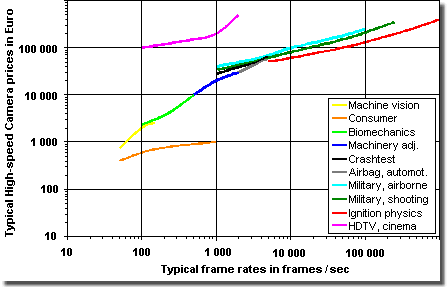
Estimated entry level prices for digital high-speed cameras,
2010/11
The enormous price margin in the figure shown on
the left is due to on first hand dealing with large-scale
manufactured consumer products or standard image processing with
usual data transmission rates, while on the second hand dealing
with high-grade scientific measurement devices with special
techniques which are partly individually designed and built by
scientists and engineers.
Technology steps cause a non-smooth and non linear behavior of the
curves. Up to about VGA resolution and about 100 to 200 frames/sec
one can directly move the image date through usual interfaces
(Ethernet, FireWire, CameraLink, ...) to the PC and its harddisk.
With higher data rates (faster camera, higher resolution) one has
to place the memory inside the camera or must connect the camera
via a special interface device (framegrabber, DSP, ...) inside the
PC, refer image left below. With frame rates starting at some
100 000 frames/sec even this isn't sufficient enough. The
memory is integrated in the sensor directly grouped around each
pixel.
Special demands for military use, crash tests or broadcast (movie
and TV) increase the costs.
The start price for new equipment with VGA resolution,
monochrome and about 500 frames/sec amounts to less than
€/$ 10 000.-. With lower frame rates of roundabout
200 frames/sec the €/$ 2 500.- mentioned above maybe
possible. For instance there are available some standard consumer
camcorders and cameras capable of some hundreds (half-/full-)
frames/sec and above with VGA resolution in short sequences and
prices of partly less than €/$ 1 000.- or even
€/$ 500.-.
One, however, has to accept really rather low resolution (often
not clearly stated in the data sheet, but drastic below full
resolution), reduced image quality, restricted adjustment and
limited upgrade chances then. Not to mention the lack of
connectivity for control signals. The »upper class« - megapixel at
1 000 frames/sec at least - costs even several ten thousands
of €/$. Fast (single shot) cameras in the some 100 000
frames/sec region cost some hundred thousand €/$. (Open end
price list, of course ;-) Besides one shouldn't forget the
equipment, especially the expense for lighting and the costs for
control and analytic software.
A small rental and second hand market exists - just ask a
manufacturer or service provider for demo or used systems. Refer to
[SloMo Links] for
detailed info and links.
The OEM black-and-white chip is opened and a RGB
stripe filter on glass substrate is adjusted with high precision
(±1/4 micron) full plane on the sensitive area optically controlled
by the operating(!) sensor. The remaining cavity is filled with
special polymers to protect the bare silicon die and the bond wires
and baked in an oven. (By that the high-g ratings during crash test
applications are guaranteed, too.)
Just click on the image on the right to see what is happening
during the operation.
Seriously: The components, especially the sensors,
are special designed with high technical expenditure built in small
series with low yield, additionally selected several times and
therefore very expensive. The sole sensor often costs much more
than a complete high-end video camera. And of course, the
development and manufacturing costs for the design in of the
complete system are not insignificant, too, because the camera
systems have nothing to do with normal video at all. They provide
digital images in a special format. The camera heads wouldn't work
together with a video recorder or a CCIR (= TV) monitor at all.
Just special electronics inside the camera or inside the control
unit generate the standard video signal only.
Once a qualified visitor remarked after the tour through the
lab:
That's not high tech, you just build highest tech.
Well, indeed, semiconductor performance will increase from
generation to generation, but like now there will be limitations
due to data transfer rates. Thus processing and displaying the
images will probably cause a change of the aim: from the hunt for
speed towards improvement of the light sensitivity, less higher
frame rates, but full resolution with higher dynamic/color depth
and better image quality - Full HD 1920 x 1080p and movie industry
are just in sight. Further on the system intelligence will be
gathered in the camera head - like a camcorder. Ultra fast cameras
with Millions frames/sec especially address the military research
sector, small (rugged) cameras industry and automotive.
Nevertheless or just therefore there will be further
diversification - a growing market for smaller camera heads will
arise, too. They can easily be put inside a crash test vehicle or a
machine and then for multi-channel devices the system controls,
intelligence and even memory are put in a common used control unit
(again). Key word: separate camera head.
Additionally from the image processing sector (also:»machine
vision«) a lot of cameras show interesting specs for numerous
applications. Often VGA resolution or a bit above at some hundred
frames per second is sufficient enough. And these cameras are
rather inexpensive compared with the traditional high-speed
cameras. Besides they offer a moderate data amount for the image
processing in real time and case-by-case they are able to work as
long-term recorder directly writing their data on a harddisk.
Concerning network integration the GigE Vision interface (Gigabit
Ethernet for »machine vision«) is a high flyer - a connection based
on Gigabit Ethernet with complementary control commands - but it
is, however, only intended for standard cameras used in the
industrial image processing sector at first. With Power over
Ethernet (PoE) a camera eager for current is simply slowed down by
a non-existing potent destination device (power out of the notebook
battery?!). More interesting for high data rates are professional
studio technique interfaces like HD-SDI and from consumer field USB
3.0.
Coming from consumer market several well-known manufacturers,
especially Casio (e.g. EXILIM EX-F1), address with camcorders and
cameras, resp. the lower price and feature segment of the
high-speed camera market. (Refer to [SloMo Links]
for detailed info and links.)
More and more high-speed cameras are professionally used as
measurement devices with appropriate analysis software. One does
not watch the sequences only, but makes them automatic calculate
movement parameters like place, velocity, acceleration, ... This is
taken into account by integrating data acquisition channels, which
are able to record and store analogue or digital signals
synchronized with the frame rate. The rest is processed by suitable
evaluation software, at least in parts fully automatically.
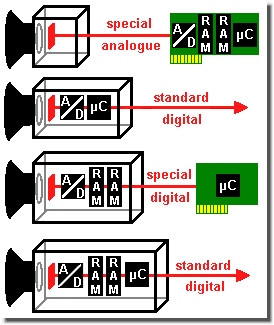
Digital high-speed camera concepts
In principle, it is. But in contrary to a comparatively simple video camera a lot of complicated electronics are necessary to handle the generated data amounts (up to and over GBytes per second). When transmission of data isn't possible any longer, they will have to be buffered inside the camera. The additional demand for a »smart« or »intelligent« camera (i.e. with image processing capability, different memory modes and other features) causes - spoken in simple terms - the integration of an almost complete PC even possibly with a mass storage medium and buffer battery. That all needs space - and yet worse - produces a lot of waste heat. Up-to-date high end cameras can reach about 100 W and even surpass - in a housing with the size of a shoe box.
In the figure on the left some construction
concepts of digital high-speed camera systems with rough comparison
of function and size. Of course, there are kinds of mixtures and
special solutions. So the image memory of very fast cameras can be
integrated in the sensor. The resolution and memory size, however,
are strictly limited by that.
The green card shall show a PC card (framegrabber, DSP board,
...), the red line connection possibilities (image and control
data).
Legend: RAM = image memory; µC = microcontroller or processor; A/D
= analogue to digital conversion (often already integrated in the
sensor)
The standard connection can be e.g. (Gigabit) Ethernet, FireWire
or CameraLink. Even a HD-SDI interface for a mass storage device
could be possible. The special connection depends of the individual
manufacturer.
Moreover if the camera has to withstand high mechanic loads
(shock, vibration) with durability and repeatedly, one will avoid
active cooling using a fan. Only the housing is used as passive
heat sink and demands a certain (surface) size. Besides desired
robustness and shock strength force certain material thickness,
lockpin and fastening systems, refer to the exploded assembly drawing (pdf, 146 kB) of a
crash-proofed digital high-speed camera.
Besides one must take into account that in general due to the
shorter times of exposure compared with conventional cameras the
pixel do not turn to be too small and therefore get too light
insensitive. That makes the high-speed camera sensors grow and
thus increases the size of cameras and lenses. (Usually not
combined with cheap prices.)
Nevertheless, or just therefore, various systems for different
applications exist. For instance such with one or more separate
imagers (camera heads) connected to a basic station with the main
part of the camera and control electronics inside.
Easy, indeed. But each user has different demands. It is
not only a matter of costs, it is also a matter of equipment (e.g.
illumination), experience, experimental set-up and so on. There is
a costly trade of between resolution, frame rate and duration of
recording.
And it makes no sense to shoot some 10 frames in ultra short
time of a process that last half a second. You won't capture the
complete process and the resolution may be too low to visualize
structural details.
On the other side a too extreme slow-motion will turn the movement
study in a boring thing. So many of the sequences shown in animal
films are shot (or replayed, resp.) at a maximum of some hundred
frames/sec. Even if the speaker tells you cameras with some
thousand frames/sec were used. Just imagine a cheetah at top speed
filmed with 1 000 frames/sec moves about two finger wide from
frame to frame.
And when slowing down this ultra-fast high-speed camera? Well, why
purchasing an expensive camera with features you will never use, or
which shows its limitations somewhere else just due to its speed,
e.g. resolution, when there are available cameras much more
suitable for your application? 1 million frames per second or more
are not for free.
Then, however, if one hasn't really extraordinary demands and
isn't too modest concerning performance figures it won't be
impossible to find a standard »one fits all« device.
Exactly, that's all right so far. In contrast, however, to a couple of years ago a lot of vendors bustle in the high-speed camera market, or what they want to sell you as that.
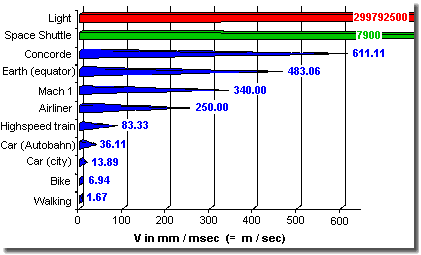
Some selected velocities
Why not just turn the tables and use the demands of the application as guidance only? The most expensive or the fastest camera system with the highest pixel count need not always be the best qualified one. Often it is exclusively designed for special applications and needs adequate accessories (illumination, control devices, equipment, ...) and user know-how.
The figure on the right gives you some insight what
happens in a microsecond or what is behind the unit meter per
second.
1 km/h = 3,6 m/s; 1 m/s = 0,2778 km/h; Mach 1
= speed of sound (in air) (1 meter = 39.370 inches = 3.281 feet =
1.094 yards)
Some other examples: An airbag is pumped up within 30
milliseconds. The human eye-shut reflex needs about 200 to 250
milliseconds.
So it definitely makes no sense to shoot human movement with much
more than 1 000 frames/sec ore even 100 000 frames/sec.
And even a car travelling with 50 km/h (about 31 mph)
moves from frame to frame less as wide as a finger. The impression
of dynamic is completely lost and you will fall asleep when
watching replay.
Or to say it with Douglas R. Hofstadter's Zeno: »Movement
unexists« (aus Gödel, Escher, Bach: an Eternal Golden
Braid).
These pages here should just bring a little light in the darkness, should show relationships and should explain basic characteristics - thus should offer some kind of a small buyer's guide for »real« high-speed cameras. Thus just a small educational lesson about speed, frame rate, resolution, illumination, image quality and data.
The speed of the object in the image plane and the desired
resolution in time, resp. provide clues for the necessary frame and
shutter rates: How many photos per second are necessary? How much
movement during time of exposure and especially between photos is
tolerable?
Some proposed and typical, resp., frame rates (frames per second,
fps): human movement analysis and special effects about 100 ... 250
fps, very fast sports and industrial adjustment about 500 ...
1 000 fps, car crash test about 1 000 ... 3 000 fps,
air-bag tests about 3 000 ... 5 000 fps, explosions,
cracks, gunfire and rockets in flight up to about 10 000 fps,
lightning flashes, discharge and rifle bullets about 10 000 ...
100 000 fps, shells and penetration 100 000 ...
500 000 fps, chemical and physical reaction research about
100 000 ... 1 000 000 fps and above.
The spatial resolution and the size of the scene affect the lens
selection (field of view) and only then the sensor resolution
(pixel count). Take notice of possibly correlation between
resolution and frame rate. Expensive steps in technology are
combined with sensor resolution.
Some proposed pixel resolutions: industrial adjustment and gait
analysis about 512 x 512 or 640 x 480 (VGA, PAL, NTSC) and less,
automotive about 1000 x 1000, special effects 1280 x 720 (HDTV) and
Full HD 1920 x 1080( 16:9!) or better, up to Digital Cinema
resolution and above (3D).
Even low resolutions, e.g. 256 x 256 and even below, will be able
to provide results of sufficient quality for industrial
applications if real black-and-white cameras are used.
Just have a look on the example sequences shown in [SloMo
Clips]. A high resolution gets interesting when enabling
covering the scene with less cameras.
The recording time is a severe cost driving factor. Using intelligent trigger modes leads to a reduction of efforts - according to comedian Otto Waalkes »The shorter the ssst, the faster the bang!« It needs not always a long time recorder with possibly reduced frame rate and resolution at high costs.
Saving, postprocessing and wishes for image processing, resp.,
rise demands for technology, image quality (HDTV, movie?), access
(download times!) and storage (memory card, LAN + RAID, HD-SDI,
...).
Just saving (downloading from the camera memory) alone can be at
first sight astonishing time consuming or turn expensive due to the
high performance interfaces and media.
Light is a precious good, because time of exposure often is
short. For e.g. 1 000 frames/sec mean that there is not more
than 1/1 000 second time of exposure for each single frame -
if ever.
Especially for outdoor applications (depth of view, clouds!) and
ballistic shots (reduced time of exposure by a shutter in order to
reduce motion blur) light sensitivity is an important criterion.
Monocolor could be an option.
Options (improved shock resistance, extended temperature range, ...) and equipment (clock dividing devices for synchronizing, special lighting, ...) can considerably push the price. With a high-speed photo camera out of the consumer sector, however, one will not have much fun in harsh industrial environment.
Do not forget to check integration in your environment and
systems (PLC and IT connections), control software (adequate,
stable, easy to use?) and special equipment (special lenses,
control devices, ...).
From somewhere the (suitable!) trigger signal and possibly other
control signals have to come from and possibly generated control
signals (strobe out = exposure active, all armed = ready for shot,
...) and image data have to be sent to somewhere, too.
Out of practical experience: Have an eye on adequate and suitable (robust) housing, connectors and cables. Just imagine - how often a RJ45 patch cable can be plugged/unplugged by an unskilled hand.
Check whether the equipment is modular concerning upgrade options, exchange, service and maintenance/repair. The technology and product cycles, however, fortunately are not as short as in computer business.
Try to get a demo and perhaps think about rental service. This can make the start easier, reduces costs and provides experience. Especially concerning tricky shooting setups. In order to reduce costs also ask a manufacturer for rental, used and demo equipment. Possibly better than creating it on your own or buying it anywhere.
Just some additional technical sensor info, tips and tricks for shooting you will find here:
©WP (1998 -) 2012
http://www.fen-net.de/walter.preiss/e/slomofaq.html
Update: V8.4, 2012-03-02